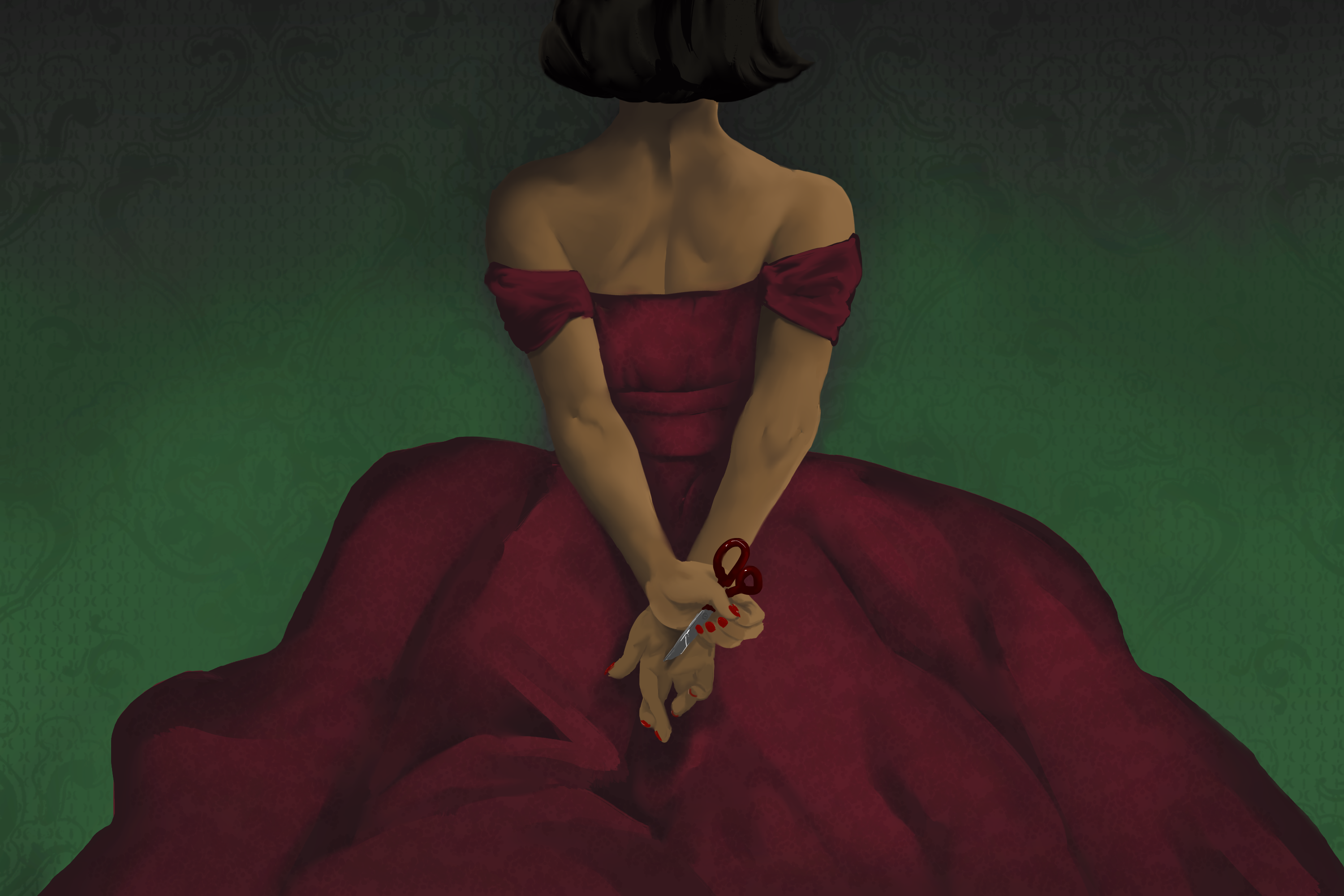
It’s October. The leaves are changing, pumpkin-spiced foods surround you everywhere you go, and you’re looking for a story that makes you terrified to walk down that dark foreboding hallway at night.
During this time of endless streaming options, it’s definitely a valid choice to check out the latest slasher flick, psychological thriller, or bad B-movie to get your fix of horror media. But for those looking for a slow-burn that allows you to really get into the heads of characters, consider picking up a horror novel for the spooky season.
With that, we’re going to be looking into Mexican Gothic, the 2020 novel from author Silvia Moreno-Garcia. Moreno-Garcia’s novel has often been compared to the works of playwright Daphne du Maurier and director Guillermo del Toro. The cover is a striking red and green arrangement that presents a glimpse of our lead heroine and invites readers to find out the true face that lurks past her strategically hidden eyes.
Set in 1950’s Mexico, Noemí Taboada is a young and fun-loving “socialite,” as the opening scenes introduce us to a woman that leaves fancy dress parties fashionably early and who cavorts with a gentleman whom her father does not strictly approve of. From the first chapter, the book lets you know that fashion sense is of high value to her, specially noting her “green gown with white appliqué flowers.” She comes off as a little spoiled, but always interesting and charming to those around her nonetheless. Our heroine is, as the narrator states, “expected to devote her time to the twin pursuits of leisure and husband hunting.” With details like that, what comes next adds a decidedly different tone.
The plot kicks off when Noemí receives a rambling and foreboding letter from her cousin, Catalina, who in years prior, married into an English family via her husband Virgil Doyle, and settled in a remote area of Mexico. In the letter, Catalina says she’s being poisoned and that the walls of her husband’s family mansion, dubbed High Place, are melting around her. She describes being bound with “threads like iron through [her] mind and skin.” At the urging of her father, and the promise to allow her to attend graduate school if she agrees to the task, Noemí travels to meet her cousin and check up on her.
When Noemí finally arrives at High Place, she is greeted by a crumbling Victorian mansion, along with the morose Doyle family that Catalina married into. Much like the mansion, the principal members of the Doyle clan are unsettling and rotten beneath the surface. They consist of the handsome but condescending Virgil; his shy brother, Francis; their strict sister, Florence; and the family patriarch, Howard. The novel follows Noemí’s efforts to help her cousin, while discovering most of the Doyles’ old-fashioned mindset, strange discussions of “purity,” and dark family secrets.
What works about the novel is its unique spin on classic gothic tropes, as well as the ominous atmosphere it builds as readers uncover the mystery along with Noemí. Noemí herself is a likable and headstrong protagonist, standing apart from the mousy gothic heroine of days past. Even surrounded by the antiquity that encompasses High Place, Noemí puts effort into “defying the gloom around her.” Her charm and wit make her easy to root for, especially as she faces off against characters who prod her about her background to get a rise out of her. Moreover, the setting is incredibly eerie. Moreno-Garcia’s writing is vividly descriptive, and as High Place comes to life with details of creaky doors, ghostly white sheets covering furniture, and dark molding corridors, it’s easy to feel trapped right along with our protagonist. Moreno-Garcia employs more of a classic style of writing, somewhat reminiscent of the 1950s, that serves to further set the scene, creating a feeling of being transported to a different time.
Additionally, Mexican Gothic uses the gothic horror genre as a way to discuss larger topics and tap into fears of colonialism and lack of agency for women. The Doyles’ family library contains so many books on so-called “race betterment” that Noemí finds herself wondering if they happen to have a pair of calipers lying about. Still, the prejudices and emphasis on twisted ideas of “tradition” that they insist on enforcing combine to create a claustrophobic and uncomfortable atmosphere that Noemí is forced to fight back against mentally. As she goes deeper into High Place’s suffocating grasp, the descriptions of slippery and shifting walls that follow her from nightmare to waking life almost echo “The Yellow Wallpaper” by Charlotte Perkins Gilman, blurring the lines between what is a true delusion and what is the result of a sinister confinement.
Where the story falls flat is in its ultimate reveal. Without giving any major spoilers, the book spends over half of the novel making you wonder what is going on with little in the way of clues. When the reveal does pop off, it’s a little confusing, as explanations are unceremoniously packed into the last few chapters where the pacing immediately shifts to feeling rapid. I found myself going back some pages to make sure I hadn’t missed anything crucial. While the plot wraps up in a satisfying manner, I wish Moreno-Garcia had taken time to make the pacing throughout the novel more consistent. Some elements of the bizarre and supernatural are expected from the very moment Noemí reads Catalina’s peculiar letter, but it’s possible this could have been weaved into the narrative a little earlier so as to not feel as if it’s coming out of left field.
Overall, Mexican Gothic is a novel that sticks with you, for better or for worse. This is largely due to its visceral imagery and taboo themes. If you’re a Gothic lover who loves novels such as Wuthering Heights and Jane Eyre, or you’re just wanting something a little different, absolutely. While I am always interested in a novel with new takes on this particular horror genre, Mexican Gothic is definitely not for everybody. It’s descriptions and reveal are a bit mind-warping and it is decidedly not afraid to incorporate themes of sci-fi, magical realism, and historical fiction. On the other hand, if you are still looking for a fun horror read for the fall, check out the following list!
If you’re looking for something darker: try The Troop by Nick Cutter. This is a great choice if you read Lord of The Flies in high school and thought it needed more gory details. The Troop follows a group of young Boy Scouts and their Scoutmaster that are stuck on a remote island for a weekend excursion. While there, they are exposed to a biologically engineered virus that causes them to behave in disturbing ways. Reader beware for body horror.
For those looking for another slow-burn: try We Have Always Lived in the Castle by Shirley Jackson. This short work by the Haunting of Hill House writer follows the secluded lives of the Blackwood sisters, who live alone after the tragic deaths of previous family members. Their hostile neighbors and the arrival of a strange cousin into their lives suddenly turn things around and makes the reader wonder what’s actually happening beneath the surface.
For those looking for something visual: try Uzumaki: Spiral into Horror by Junji Ito. Ito’s Uzumaki is a horror anthology that follows the town of Kurouzu-cho, a place haunted by mysterious spirals. Each self-contained chapter follows how something as strange and seemingly harmless as a spiral can overtake a town and ruin the lives of its inhabitants. The beautiful yet disturbing black and white illustrations add to the sense of terror and give a new experience in psychological horror.
For those looking for something supernatural: try Come Closer by Sara Gran. Come Closer follows Amanda, a woman who has suddenly become overcome with mood swings, obscene thoughts, and disturbing actions. The tapping in the walls of her apartment follows her, and one day Amanda receives a book she didn’t order on how to tell if you’re possessed by a demon and she starts wondering about puzzling urges that have overtaken her daily life.
For those looking to completely confuse those around you: try House of Leaves by Mark Danielewski. Yes, you should absolutely try to get the physical copy over the digital one, if you can. And yes, reading this in public will have strangers look at you in confusion as you struggle to read the text. In simple terms, this book follows a family who discovers their new home is bigger on the inside than it is on the outside. Yet nothing about House of Leaves is simple, as you follow meta-narratives, intertwining plot lines, and puzzles. The book to read if you love puzzles and research, or you just get a kick out of strangers in public raising their eyebrows at your reading choices.

Comments